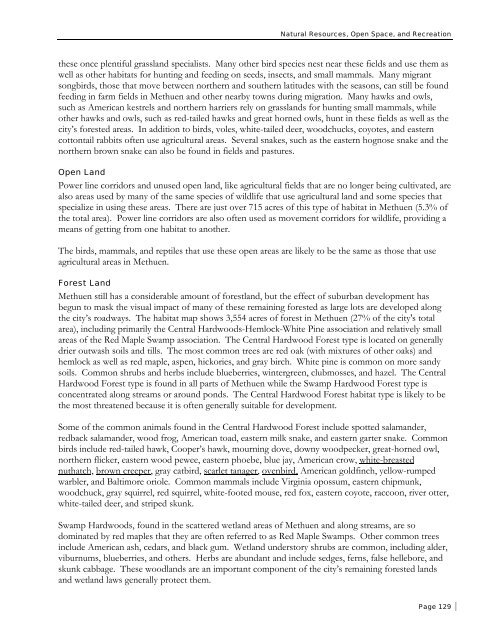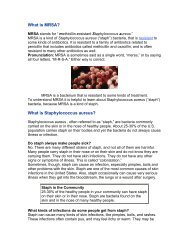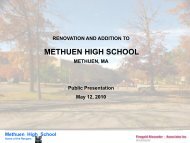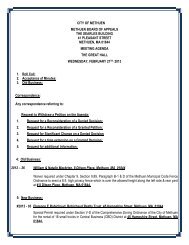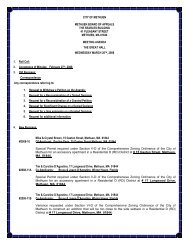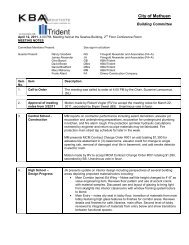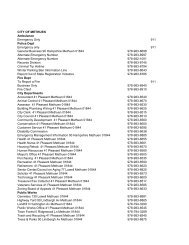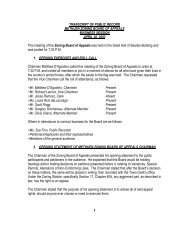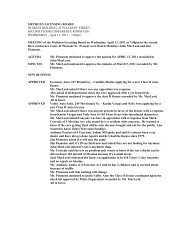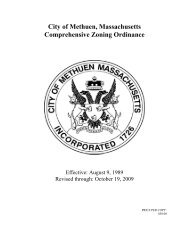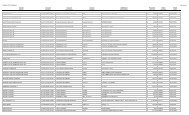City of Methuen Master Plan
City of Methuen Master Plan
City of Methuen Master Plan
Create successful ePaper yourself
Turn your PDF publications into a flip-book with our unique Google optimized e-Paper software.
Natural Resources, Open Space, and Recreation<br />
these once plentiful grassland specialists. Many other bird species nest near these fields and use them as<br />
well as other habitats for hunting and feeding on seeds, insects, and small mammals. Many migrant<br />
songbirds, those that move between northern and southern latitudes with the seasons, can still be found<br />
feeding in farm fields in <strong>Methuen</strong> and other nearby towns during migration. Many hawks and owls,<br />
such as American kestrels and northern harriers rely on grasslands for hunting small mammals, while<br />
other hawks and owls, such as red-tailed hawks and great horned owls, hunt in these fields as well as the<br />
city’s forested areas. In addition to birds, voles, white-tailed deer, woodchucks, coyotes, and eastern<br />
cottontail rabbits <strong>of</strong>ten use agricultural areas. Several snakes, such as the eastern hognose snake and the<br />
northern brown snake can also be found in fields and pastures.<br />
Open Land<br />
Power line corridors and unused open land, like agricultural fields that are no longer being cultivated, are<br />
also areas used by many <strong>of</strong> the same species <strong>of</strong> wildlife that use agricultural land and some species that<br />
specialize in using these areas. There are just over 715 acres <strong>of</strong> this type <strong>of</strong> habitat in <strong>Methuen</strong> (5.3% <strong>of</strong><br />
the total area). Power line corridors are also <strong>of</strong>ten used as movement corridors for wildlife, providing a<br />
means <strong>of</strong> getting from one habitat to another.<br />
The birds, mammals, and reptiles that use these open areas are likely to be the same as those that use<br />
agricultural areas in <strong>Methuen</strong>.<br />
Forest Land<br />
<strong>Methuen</strong> still has a considerable amount <strong>of</strong> forestland, but the effect <strong>of</strong> suburban development has<br />
begun to mask the visual impact <strong>of</strong> many <strong>of</strong> these remaining forested as large lots are developed along<br />
the city’s roadways. The habitat map shows 3,554 acres <strong>of</strong> forest in <strong>Methuen</strong> (27% <strong>of</strong> the city's total<br />
area), including primarily the Central Hardwoods-Hemlock-White Pine association and relatively small<br />
areas <strong>of</strong> the Red Maple Swamp association. The Central Hardwood Forest type is located on generally<br />
drier outwash soils and tills. The most common trees are red oak (with mixtures <strong>of</strong> other oaks) and<br />
hemlock as well as red maple, aspen, hickories, and gray birch. White pine is common on more sandy<br />
soils. Common shrubs and herbs include blueberries, wintergreen, clubmosses, and hazel. The Central<br />
Hardwood Forest type is found in all parts <strong>of</strong> <strong>Methuen</strong> while the Swamp Hardwood Forest type is<br />
concentrated along streams or around ponds. The Central Hardwood Forest habitat type is likely to be<br />
the most threatened because it is <strong>of</strong>ten generally suitable for development.<br />
Some <strong>of</strong> the common animals found in the Central Hardwood Forest include spotted salamander,<br />
redback salamander, wood frog, American toad, eastern milk snake, and eastern garter snake. Common<br />
birds include red-tailed hawk, Cooper’s hawk, mourning dove, downy woodpecker, great-horned owl,<br />
northern flicker, eastern wood pewee, eastern phoebe, blue jay, American crow, white-breasted<br />
nuthatch, brown creeper, gray catbird, scarlet tanager, ovenbird, American goldfinch, yellow-rumped<br />
warbler, and Baltimore oriole. Common mammals include Virginia opossum, eastern chipmunk,<br />
woodchuck, gray squirrel, red squirrel, white-footed mouse, red fox, eastern coyote, raccoon, river otter,<br />
white-tailed deer, and striped skunk.<br />
Swamp Hardwoods, found in the scattered wetland areas <strong>of</strong> <strong>Methuen</strong> and along streams, are so<br />
dominated by red maples that they are <strong>of</strong>ten referred to as Red Maple Swamps. Other common trees<br />
include American ash, cedars, and black gum. Wetland understory shrubs are common, including alder,<br />
viburnums, blueberries, and others. Herbs are abundant and include sedges, ferns, false hellebore, and<br />
skunk cabbage. These woodlands are an important component <strong>of</strong> the city’s remaining forested lands<br />
and wetland laws generally protect them.<br />
Page 129


